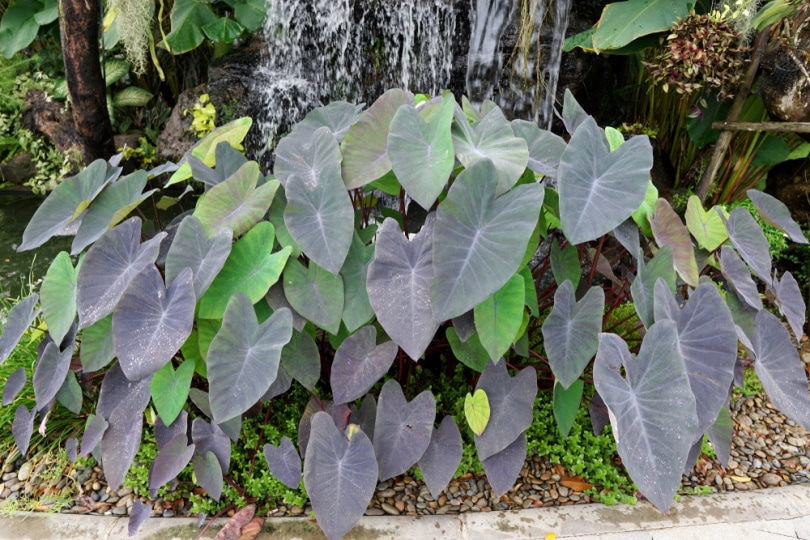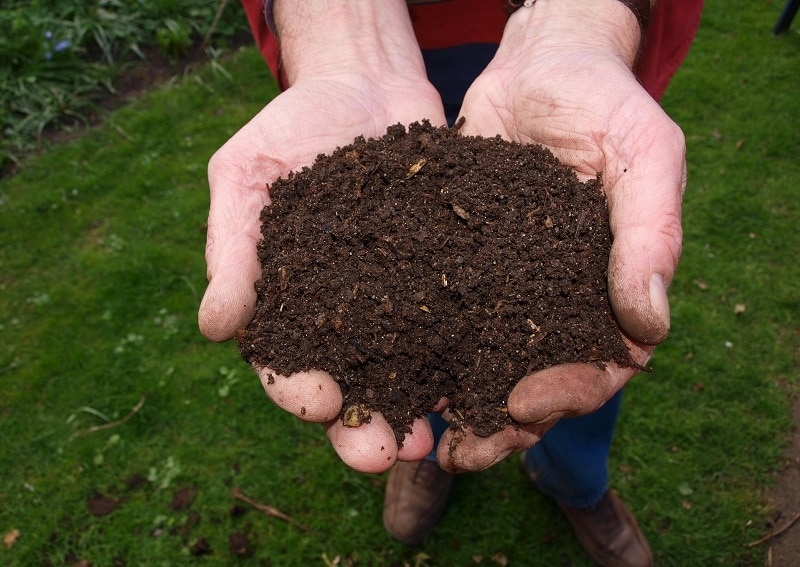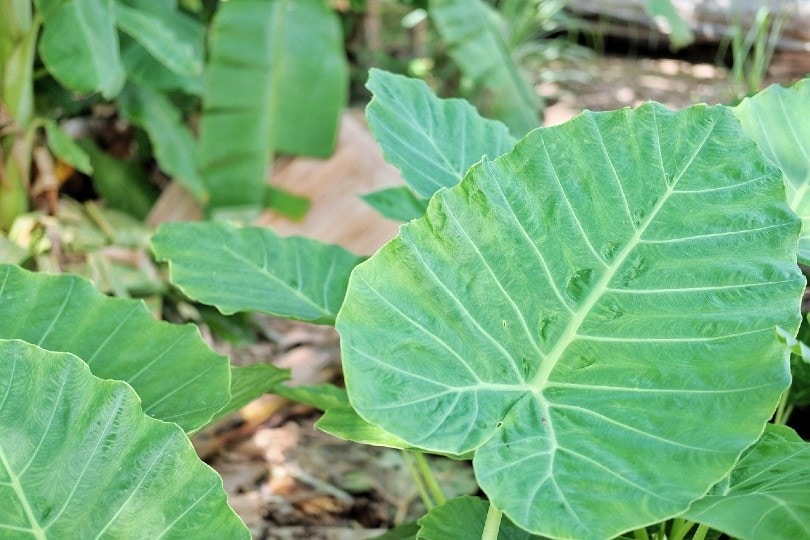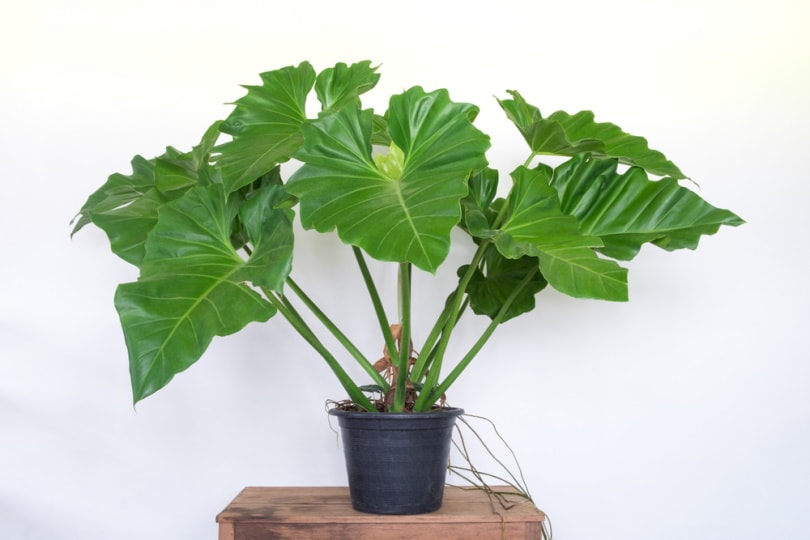How & When to Plant Elephant Ear Bulbs: Preparation, Soil, Steps, & Tips
-
Caroline Bonin
- Last updated:

Elephant ear is the common name for several groups of perennial plants, including Colocasia esculenta (taro) and Alocasia macrorrhizos (giant elephant ear), the two types most familiar to gardeners.
These vibrant tropical plants are known for their spectacularly large leaves, which give them their name. Gardeners love them for their showy foliage, tropical feel, and quick growing time. They make a beautiful addition to any garden and can be grown as annuals or perennials.
Though there are multiple types of elephant ears, they are all planted the same way. We’ll walk through the steps and get you set up for the biggest, brightest elephant ears in your garden or in containers.
Before You Start
Before you dive into planting your elephant ear bulbs, it’s essential to get to know the plant, determine what type you want in your space, and plan ahead for optimal care.
The first decision you need to make is whether to choose taro or giant elephant ear. This depends on how much available space you have in your garden and how large you want the plant to be. Taro plants typically grow 3–6 feet tall and have leaves 2 feet in length. Giant elephant ears can grow up to 15 feet tall, with leaves 6 feet long and 4 feet wide.
Once you’ve made that decision, you’ll need to settle on a variety. While elephant ears are most commonly seen in a bright green color, there are many other variations that can add diversity to your landscaping.
Whichever you choose, you will follow the same planting instructions. All elephant ear bulbs are planted the same way and require the same conditions to flourish.

When to Plant Elephant Ears
Elephant ears are tropical plants, which means that you should always wait to plant the bulbs until after the final frost of the season. The tubers won’t grow unless the soil is at least 65°, which means late June for most northern climates.
To determine whether you will grow elephant ears as perennials or annuals, you will need to know your hardiness zone. In zones 9-11, elephant ears can be grown in the ground year-round, but in zones 3-8, where it’s cooler, you have to plant them in the spring as annuals. They will not survive freezing temperatures.
Elephant ears will grow in either sun or shade, but if you plant them in a location with adequate sunlight, make sure they can get shade around midday.
What Kind of Soil to Use for Elephant Ears
Elephant ears are known in the gardening community as “big eaters,” meaning they require a lot of fertilizer to grow and thrive. They do best with rich, moist soil mixed with organic matter, such as compost.
They also prefer a soil pH between 5.5 and 7.0. If you need to change your soil’s pH, you can add lime to raise it or sulfur to lower it.
Before you plant your bulbs, prepare the garden bed by turning the soil and digging a hole to a depth of 8 inches. Make sure to remove any grass, stones, or other debris from the soil, then level out the bed when you’re finished.

Planting Elephant Ear Bulbs in Your Garden
Now that you’ve got your bulbs and your garden ready, it’s time to plant your elephant ears.
- Dig your holes: They need to be 2–5 inches deep, depending on the side of your bulbs. The holes should be 2–4 feet apart from each other.
- Plant the bulbs: Place them in the holes with the pointy side up. The top of the bulb should be about 1 inch below the surface.
- Add the finishing touches: Cover the bulbs with soil and water thoroughly.
Planting elephant ear bulbs is simple, but your work doesn’t end there. Once you’ve planted them, you’ll need to make sure you care for them adequately, which we’ll cover later in this article.

Planting Elephant Ear Bulbs in Containers
Elephant ears do just as well in containers as they do in the ground, provided you care for them correctly. You’ll need to adhere to the same conditions as you would in the garden, making sure they get enough sun, warmth, and moist, well-fertilized soil.
- Choose the right container: Elephant ear plants are large, so check how big yours is going to become and pick a container with proper dimensions.It’s also important to choose a container made of a non-porous material for maximum moisture retention, and to make sure it has holes for drainage in the bottom.
- Find the right spot: You’ll need to ensure your plants will get the right amount of sun.
- Fill the container with soil: It’s not recommended to use soil directly from your garden, as you could be introducing bacteria or pests to the sterile bulbs. Choose a commercial potting soil instead.
- Plant your bulbs: You’ll want to make the hole big enough to accommodate the tuber with an inch of soil above it.
- Water thoroughly: Elephant ears love moisture, so don’t be shy. Just make sure the pot has adequate drainage, as they don’t like standing water.
It’s that simple to plant elephant ear bulbs in containers. Next, you’ll need to ensure that you’re caring for them properly so they can grow quickly and thrive as adult plants.

Caring for Your Elephant Ear Plants
Elephant ears are as easy to care for as they are to plant. Here are some tips and tricks to help you give your elephant ear plants exactly what they need to flourish in your garden or container.
- Water regularly: Elephant ears do best in moist soil, preferring 2-3 inches of water a week. Depending on the annual rainfall, you may need to water them every day.
- Fertilize routinely: Once you see new growth from your plants, you can start fertilizing them. They benefit from a granular or liquid fertilizer applied every 2-3 weeks.
- Prune & weed: Cut back any leaves that turn brown or straggly and keep the garden bed or container free from weeds that might compete with your elephant ears for nutrients.
- Prepare for colder weather: If you live in a zone where elephant ears can’t grow year-round, you can choose to winterize your plants or dig up the bulbs for winter to plant again in the spring. You can bring plants in containers inside, but you should reduce their watering over the winter.
- Keep away from pets: Though some parts of the elephant ear can be eaten by humans—and frequently are—they can be toxic to animals. If you have pets, take necessary precautions to make sure they can’t consume them.
Elephant ears are not particularly high-maintenance plants. As long as you understand what their needs are, you will be able to enjoy their flamboyant foliage in your garden or even in your home.
Conclusion
Anyone can grow and appreciate elephant ears, no matter where they live. They are beautiful tropical plants that have become popular with gardeners and landscapers around the world, and it’s easy to see why. With their huge leaves and bright colors, they make a stunning addition to any outdoor or indoor space.
- https://bustlingnest.com/plant-elephant-ear-bulbs/
- https://planthardiness.ars.usda.gov/
- https://www.gardeningchannel.com/when-to-plant-elephant-ear-bulbs/
- https://www.burpee.com/blog/encyclopedia__elephantears-article.html
- https://www.gardeningchannel.com/grow-elephant-ears-containers/
- https://www.elephantearsplants.com/pages/elephant-ear-plants-questions-answers
- https://www.allrecipes.com/article/what-is-taro/
Featured Image Credit: Dark Caramel, Shutterstock
Contents
